Spatial and Temporal Pattern of Rainstorms Based on Manifold Learning Algorithm
Abstract
1. Introduction
2. Materials and Methods
- If the rainfall at a single station exceeded 10 mm in 5 min and existed in isolation, and there was no rainfall at the same station 30 min before and after the observation, it was considered an unreasonable record;
- If the rainfall at a single station exceeded 10 mm in 5 min, but the observed data of other rain-measuring stations within a range of 5 × 5 km of the station was 0, it was considered an unreasonable record;
- In the case of unreasonable records from a single station, the data were compared to the rainfall isosurface map of the period. If the data from the station were confirmed to be unreasonable, the interpolation results of surrounding stations within a range of 5 × 5 km were used to replace the unreasonable records of that station.
- Rainfall events were first identified. If the 5 min rainfall at all the stations was less than 0.1 mm over four consecutive hours, it was not considered effective rainfall. Two independent rainfall events were eliminated according to this standard.
- Rainstorm samples were screened according to the yellow rainstorm warning standards of Beijing and Shenzhen. Rainstorm events were selected for further analysis.
2.1. Methods and Procedures
2.2. Manifold Learning Algorithm
2.3. Dynamic Cluster Analysis and Feature Extraction
3. Results and Discussion
3.1. Results
3.2. Discussions
4. Conclusions
Author Contributions
Funding
Institutional Review Board Statement
Informed Consent Statement
Data Availability Statement
Conflicts of Interest
References
- Zhang, J.Y.; Wang, Y.T.; He, R.M.; Hu, Q.F.; Song, X.M. Discussion on the urban flood and waterlog ging and causes analysis in China. Adv. Water Sci. 2016, 27, 485–491. [Google Scholar] [CrossRef]
- Chen, X.T. Urban Water Disasters and Strategy of Comprehensive Control of Water Disaster. J. Catastrophology 2010, 25, 10–15. [Google Scholar]
- Zhang, J.Y.; Wang, Y.T.; Hu, Q.F.; He, R.M. Discussion and views on some issues of the sponage city con struction in China. Adv. Water Sci. 2016, 27, 793–799. [Google Scholar] [CrossRef]
- Rafieeinasab, A.; Norouzi, A.; Kim, S.; Habibi, H.; Nazari, B.; Seo, D.-J.; Lee, H.; Cosgrove, B.; Cui, Z. Toward High-Resolution Flash Flood Prediction in Large Urban Areas–Analysis of Sensitivity to Spatiotemporal Resolution of Rainfall Input and Hydrologic Modeling. J. Hydrol. 2015, 531, 370–388. [Google Scholar] [CrossRef]
- Onyutha, C.; Willems, P. Influence of Spatial and Temporal Scales on Statistical Analyses of Rainfall Variability in the River Nile Basin. Dyn. Atmos. Ocean. 2017, 77, 26–42. [Google Scholar] [CrossRef]
- Liu, Y.S.; Liu, Y.Y.; Li, M. Influence of rainfall spatial and temporal heterogeneity on flooding process in urban rivers. S. N. Water Transf. Water Sci. Technol. 2022, 20, 317–326. [Google Scholar] [CrossRef]
- Wang, G.; Sun, G.; Li, J.; Li, J. The Experimental Study of Hydrodynamic Characteristics of the Overland Flow on a Slope with Three-Dimensional Geomat. J. Hydrodyn. 2018, 30, 153–159. [Google Scholar] [CrossRef]
- Li, Z.J.; Jiang, T.T.; Huang, P.N.; Liu, Z.Y.; An, D.; Yao, C.; Ju, X.S. Impact and analysis of watershed precipitation and topography characteristics on model simulation results. Adv. Water Sci. 2015, 26, 473–480. [Google Scholar] [CrossRef]
- Guo, L.; Ding, L.Q.; Sun, D.Y.; Liu, C.J.; He, B.S.; Liu, R.H. Key techniques of flash flood disaster prevention in China. J. Hydraul. Eng. 2018, 49, 1123–1136. [Google Scholar] [CrossRef]
- Emmanuel, I.; Payrastre, O.; Andrieu, H.; Zuber, F. A Method for Assessing the Influence of Rainfall Spatial Variability on Hy drograph Modeling. First Case Study in the Cevennes Region, Southern France. J. Hydrol. 2017, 555, 314–322. [Google Scholar] [CrossRef]
- Fung, K.F.; Chew, K.S.; Huang, Y.F.; Ahmed, A.N.; Teo, F.Y.; Ng, J.L.; Elshafie, A. Evaluation of spatial interpolation methods and spatiotemporal modeling of rainfall distribution in Peninsular Malaysia. Ain Shams Eng. J. 2021, 13, 101571. [Google Scholar] [CrossRef]
- Hitchens, N.M.; Brooks, H.E.; Schumacher, R.S. Spatial and temporal characteristics of heavy hourly rainfall in the United States. Mon. Weather. Rev. 2013, 141, 4564–4575. [Google Scholar] [CrossRef]
- Satya, O.C.; Arsali, M.; Affandi, A.K.; Mandailing, P.M. Spatial distribution and diurnal characteristics of rainfall in South Sumatra and surrounding areas based on Tropical Rainfall Measuring Mission (TRMM) data. J. Phys. Conf. Ser. 2020, 1568, 012024. [Google Scholar] [CrossRef]
- Ndiaye, B.; Moussa, M.A.; Wade, M.; Sy, A.; Diop, A.B.; Diop, A.D. Spatial and Temporal Distribution of Rainfall Breaks in Senegal. Am. J. Clim. Change 2021, 10, 533–560. [Google Scholar] [CrossRef]
- Chaubey, P.K.; Mall, R.K.; Jaiswal, R.; Payra, S. Spatio-Temporal Changes in Extreme Rainfall Events Over Different Indian River Basins. Earth Space Sci. 2022, 9, e2021EA001930. [Google Scholar] [CrossRef]
- Audu, M.O.; Ejembi, E.; Igbawua, T. Assessment of Spatial Distribution and Temporal Trends of Precipitation and Its Extremes over Nigeria. Am. J. Clim. Change 2021, 10, 22. [Google Scholar] [CrossRef]
- Yeung, J.K. Summertime Convective Rainfall in the New York City-New Jersey Metropolitan Region. Ph.D. Thesis, Princeton University, Princeton, NJ, USA, 2012. [Google Scholar]
- Viglione, A.; Chirico, G.B.; Woods, R.; Blöschl, G. Generalised synthesis of space-time variability in flood response: An analytical framework. J. Hydrol. 2010, 394, 198–212. [Google Scholar] [CrossRef]
- Zoccatelli, D.; Borga, M.; Viglione, A.; Chirico, G.B.; Blöschl, G. Spatial moments of catchment rainfall: Rainfall spatial organisation, basin morphology and flood response. Hydrol. Earth Syst. Sci. 2011, 15, 3767–3783. [Google Scholar] [CrossRef]
- Wu, D.; Zhao, K.; Yu, H.; Wang, M.J. An analysis of spatial and temporal variations in the axisymmetric precipitation structure associ ated with typhoons making landfall on the southeastern coast of China based on the Doppler radar data. Acta Meteorol. Sin. 2010, 68, 896–907. [Google Scholar]
- Ngongondo, C.; Xu, C.Y.; Gottschalk, L.; Alemaw, B. Evaluation of Spatial and Temporal Characteristics of Rainfall in Malawi: A Case of Data Scarce Region. Theor. Appl. Climatol. 2011, 106, 79–93. [Google Scholar] [CrossRef]
- LeCun, Y.; Bengio, Y.; Hinton, G. Deep Learning. Nature 2015, 521, 436–444. [Google Scholar] [CrossRef] [PubMed]
- Liu, Y.Y.; Liu, H.W.; Huo, F.L. An application of machine learning on examining spatial and temporal distribution of short duration rainstorm. J. Hydraul. Eng. 2019, 50, 773–779. [Google Scholar] [CrossRef]
- Liu, Y.Y.; Li, L.; Zhang, W.H.; Chan, P.W.; Liu, Y.S. Rapid Identification of Rainstorm Disaster Risks Based on an Artificial Intelligence Technology Using the 2DPCA Method. Atmos. Res. 2019, 227, 157–164. [Google Scholar] [CrossRef]
- Sharma, S.K. A novel approach on water resource management with Multi-Criteria Optimization and Intelligent Water De mand Forecasting in Saudi Arabia. Environ. Res. 2022, 208, 112578. [Google Scholar] [CrossRef] [PubMed]
- Salloom, T.; Kaynak, O.; Yu, X.B.; He, W. Proportional integral derivative booster for neural networks-based time-series prediction. Eng. Appl. Artif. Intell. 2022, 108, 104570. [Google Scholar] [CrossRef]
- Sadeghifar, T.; Barati, R. Application of adaptive Neuro-fuzzy inference system to estimate alongshore sediment transport rate (A real case study: Southern shorelines of Caspian Sea). J. Soft Comput. Civ. Eng. 2018, 2, 72–85. [Google Scholar]
- Alizadeh, M.J.; Shahheydari, H.; Kavianpour, M.R.; Shamloo, H.; Barati, R. Prediction of longitudinal dispersion coefficient in natural rivers using a cluster-based Bayesian network. Environ. Earth Sci. 2017, 76, 86. [Google Scholar] [CrossRef]
- Hu, R.; Fang, F.; Pain, C.C.; Navon, I.M. Rapid spatio-temporal flood prediction and uncertainty quantification using a deep learning method. J. Hydrol. 2019, 575, 911–920. [Google Scholar] [CrossRef]
- Liu, Y.Y.; Liu, Y.S.; Zheng, J.W. Intelligent rapid prediction method of urban flooding based on BP neural network and numerical simulation model. J. Hydraul. Eng. 2022, 53, 284–295. [Google Scholar]
- Bao, Z.X.; Zhang, J.Y.; Wang, G.Q.; He, R.M.; Jin, J.L.; Wang, J.; Wu, H.F. Quantitative assessment of the attribution of runoff and sediment changes based on hydrologic model and machine learning: A case study of the Kuye River in the Middle Yellow River basin. Adv. Water Sci. 2021, 32, 485–496. [Google Scholar] [CrossRef]
- Zheng, T.F.; Liu, X.T.; Wang, Q.L.; Yu, X. The characteristics of precipitation in Guangdong Province over the past 50 years: Dependence on rainfall intensity. J. Trop. Meteorol. 2017, 33, 212–220. [Google Scholar] [CrossRef]
- Luo, C.; Liu, Y.S.; Liu, Y.Y.; Mu, J.; Liu, X.P.; Feng, M.M. A smart-framework for urban flood and waterlogging analysis. China Flood Drought Manag. 2021, 31, 17–22. [Google Scholar] [CrossRef]
- Cauteruccio, A.; Colli, M.; Stagnaro, M.; Lanza, L.G.; Vuerich, E. In situ precipitation measurements. In Springer Handbook of Atmospheric Measurements; Springer Handbooks; Springer: Cham, Switzerland, 2021; pp. 259–400. ISBN 978-3-030-52170-7. [Google Scholar] [CrossRef]
- Cauteruccio, A.; Brambilla, E.; Stagnaro, M.; Lanza, L.G.; Rocchi, D. Experimental evidence of the wind-induced bias of precipitation gauges using Particle Image Velocimetry and particle tracking in the wind tunnel. J. Hydrol. 2021, 600, 126690. [Google Scholar] [CrossRef]
- Belkin, M.; Niyogi, P. Laplacian Eigenmaps for Dimensionality Reduction and Data Representation. Neural Comput. 2003, 15, 1373–1396. [Google Scholar] [CrossRef]
- Roweis, S.T.; Saul, L.K. Nonlinear Dimensionality Reduction by Locally Linear Embedding. Science 2000, 290, 2323–2326. [Google Scholar] [CrossRef]
- Hartigan, J.A.; Wong, M.A. Algorithm AS 136: A K-Means Clustering Algorithm. Appl. Stat. 1979, 28, 100. [Google Scholar] [CrossRef]
- Chen, Z.H.; He, G.B.; Cui, C.G. The coupling reaction among convective cloud cluster and moisture frontal zone and low level jet—A possible mechanism of maintenance of continuing heavy rain. J. Trop. Meteorol. 2007, 23, 246–254. [Google Scholar]
- Hu, Y.; Du, Y.; Luo, X. Precipitation Patterns During the “Dragon Boat Water” in South China for the Recent 49 Years. Meteor. Mon. 2013, 39, 1031–1041. [Google Scholar]
- Huang, R.H.; Chen, G.H. Besearch on interannual variations of tracks of tropical cyclones over northwest pacific and their physical mechanism. Acta Meteorol. Sin. 2007, 65, 683–694. [Google Scholar]
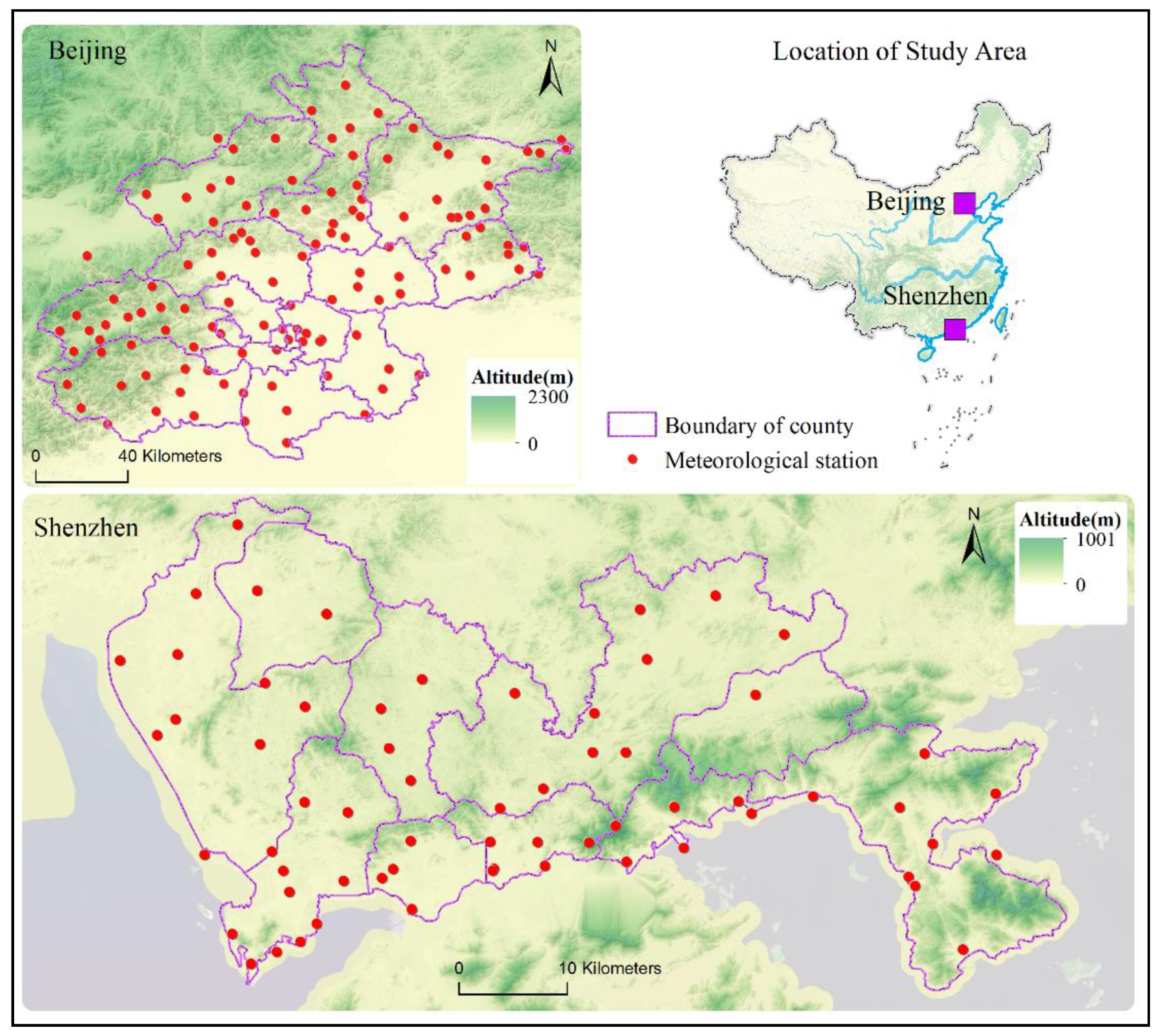
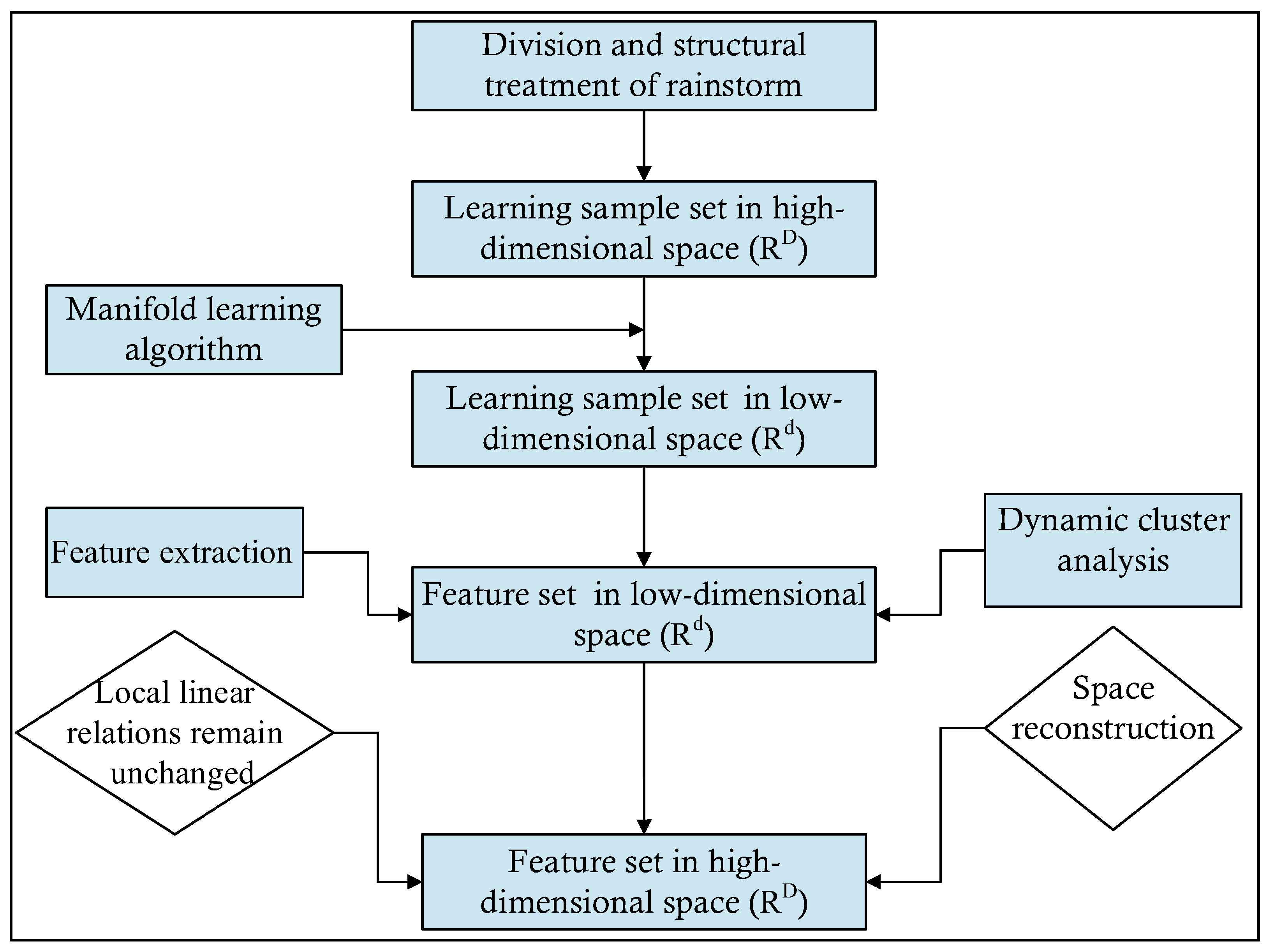

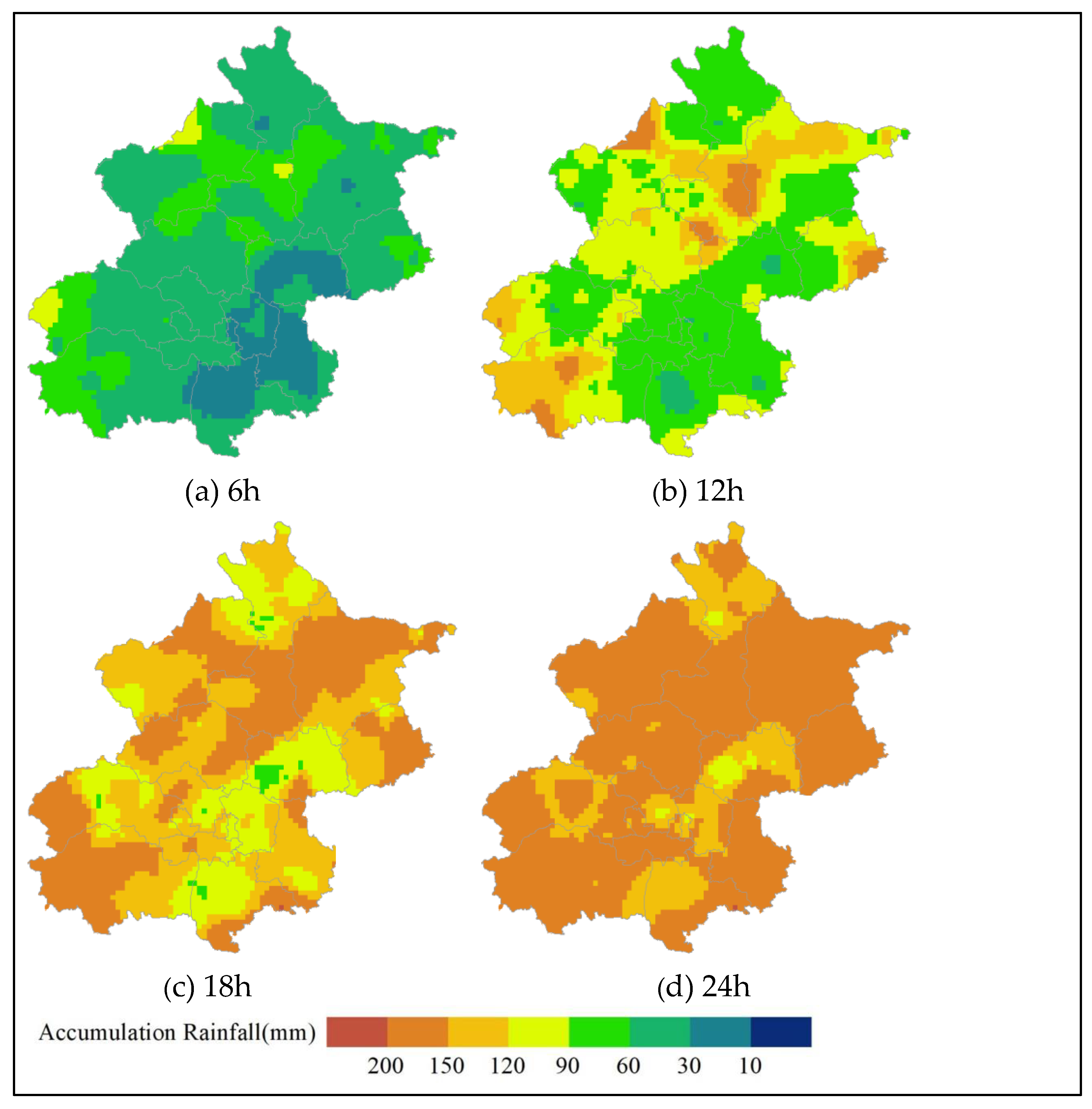
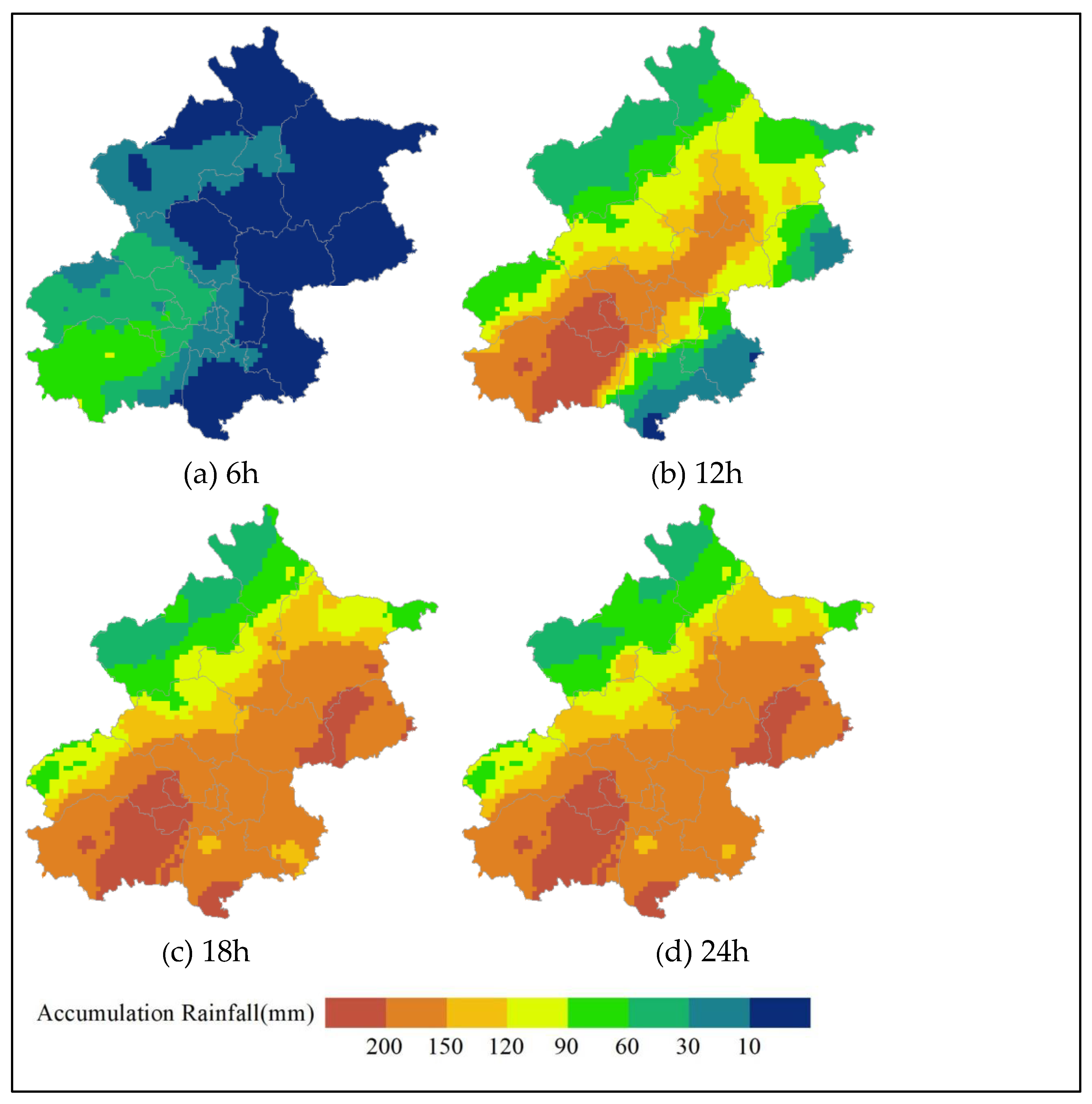

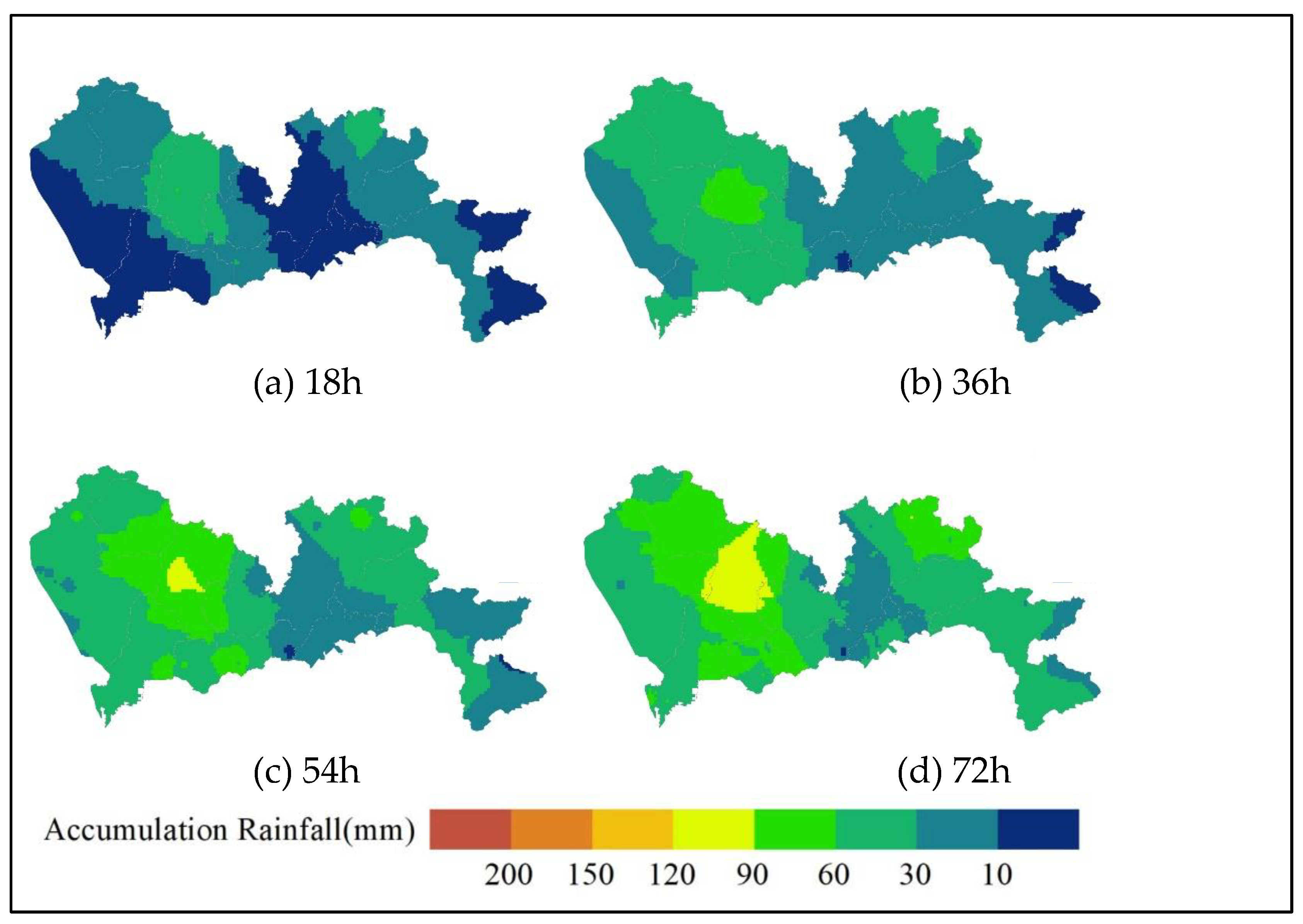
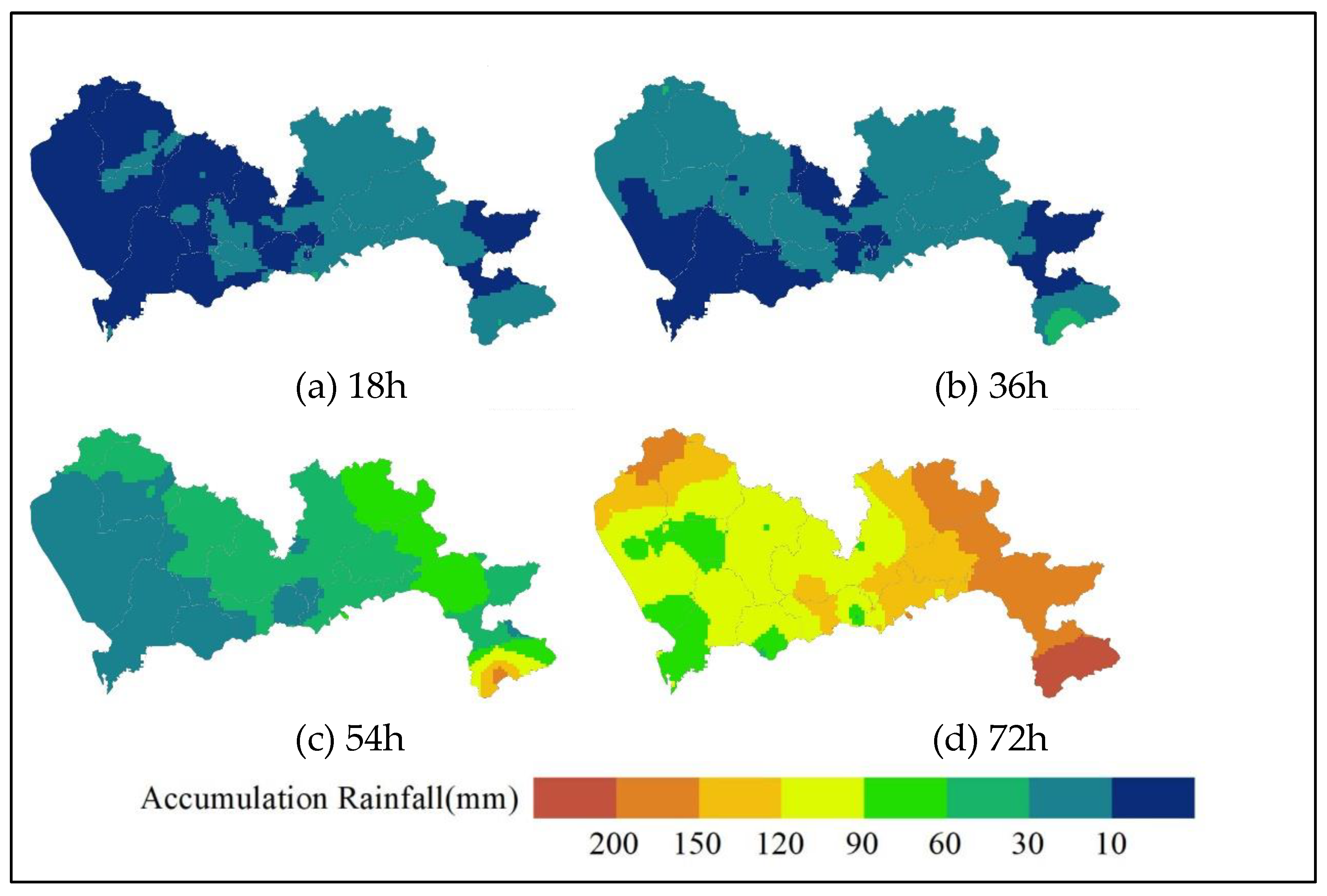
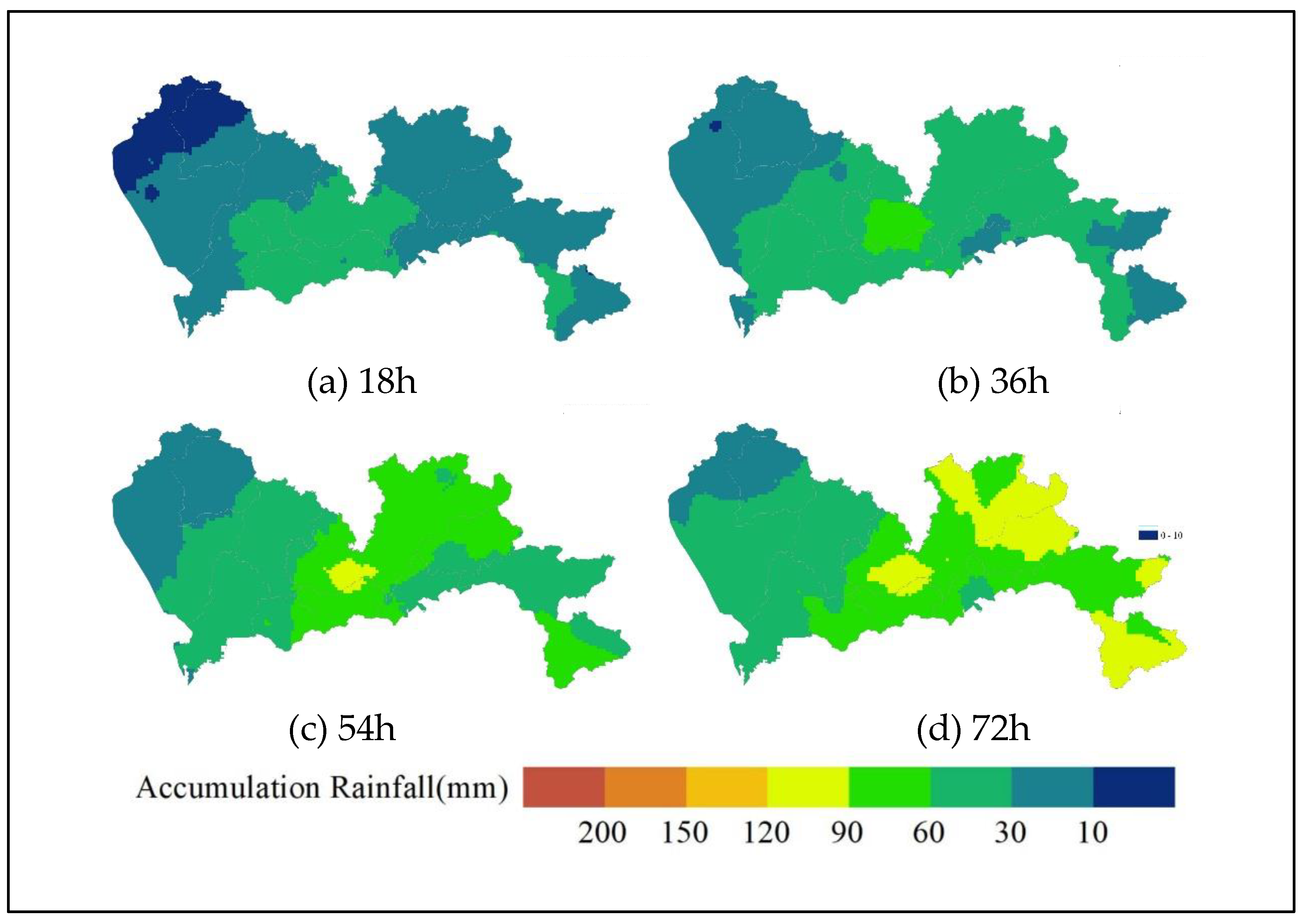
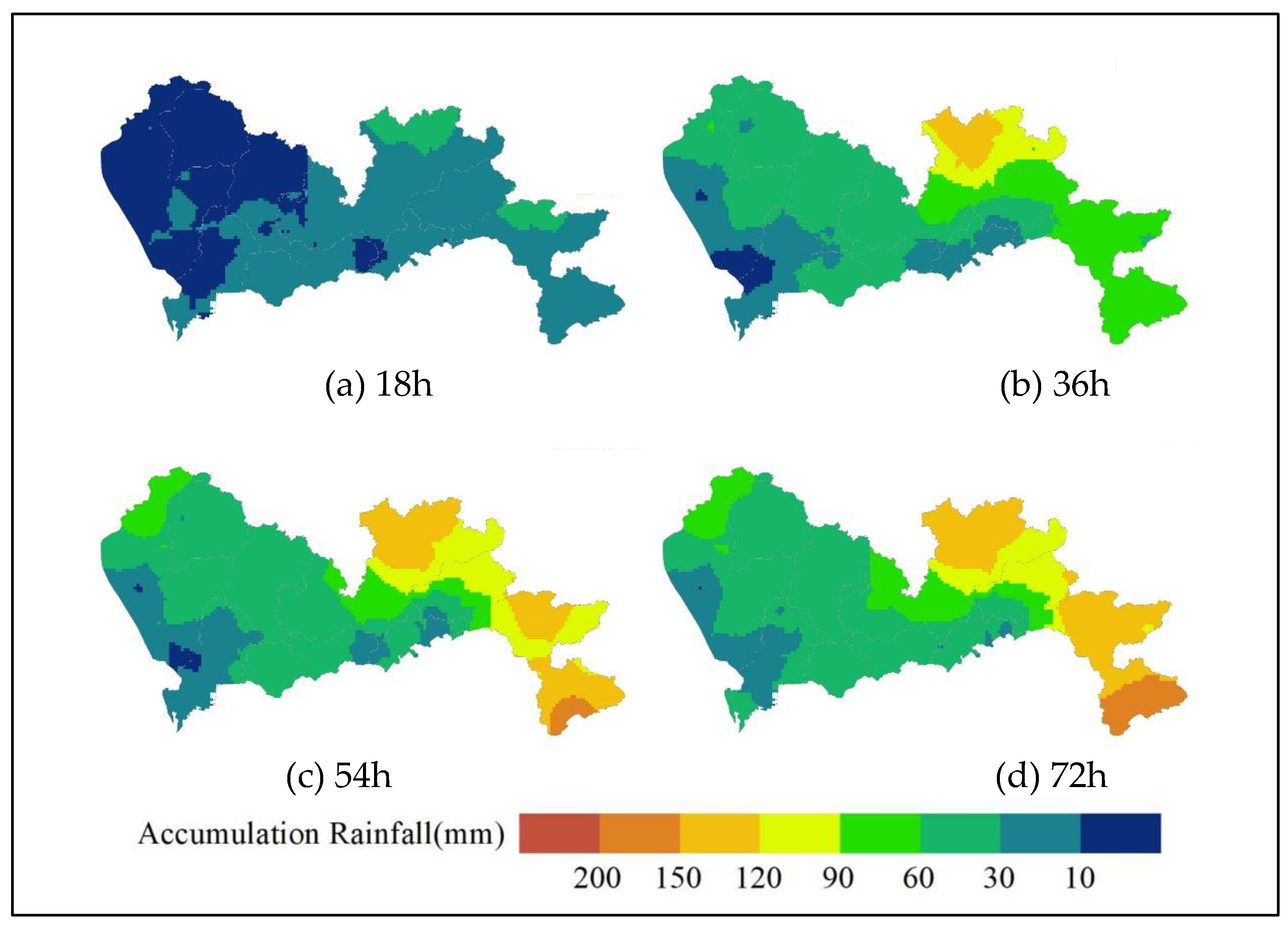
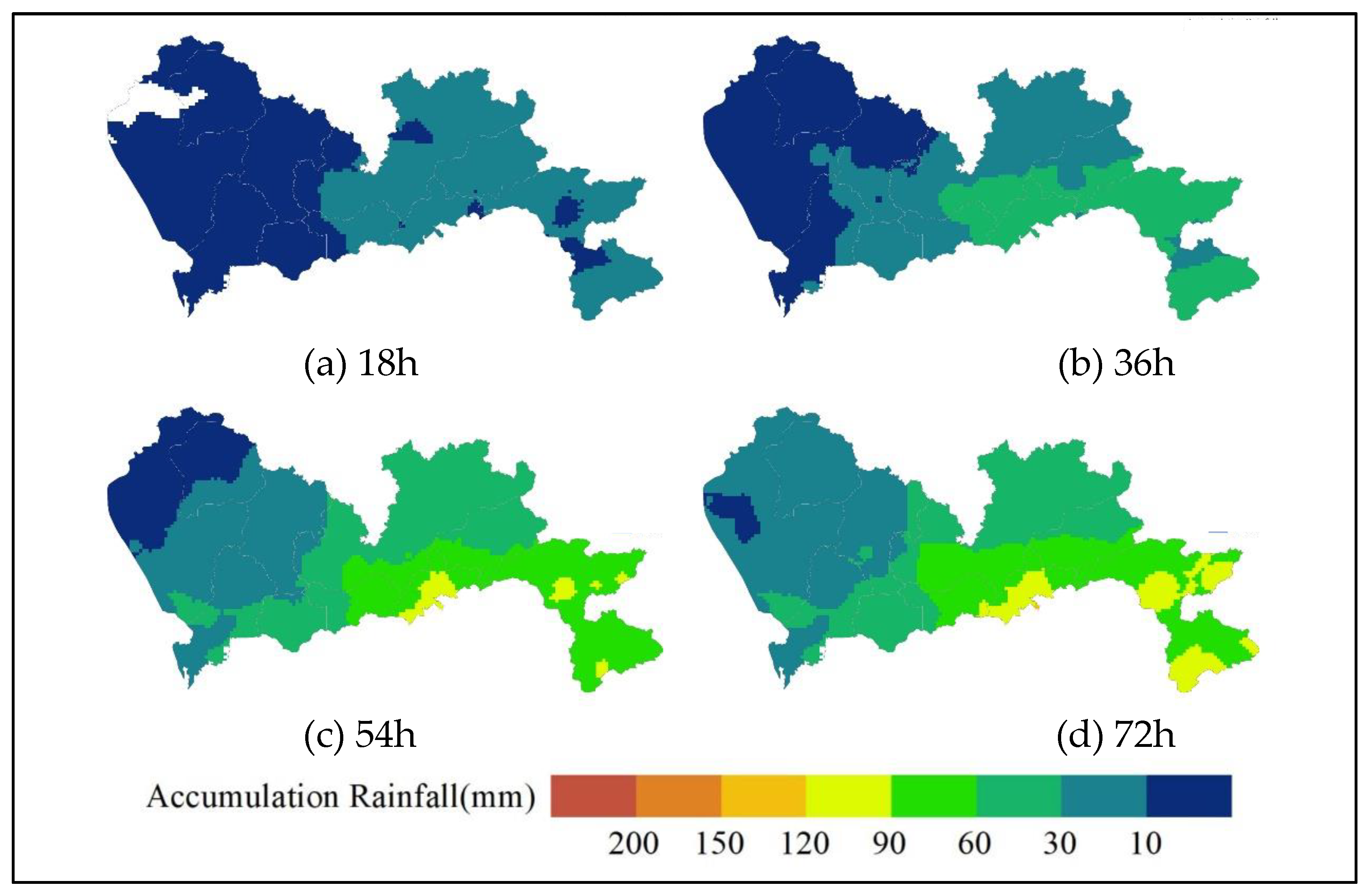
Disclaimer/Publisher’s Note: The statements, opinions and data contained in all publications are solely those of the individual author(s) and contributor(s) and not of MDPI and/or the editor(s). MDPI and/or the editor(s) disclaim responsibility for any injury to people or property resulting from any ideas, methods, instructions or products referred to in the content. |
© 2022 by the authors. Licensee MDPI, Basel, Switzerland. This article is an open access article distributed under the terms and conditions of the Creative Commons Attribution (CC BY) license (https://creativecommons.org/licenses/by/4.0/).
Share and Cite
Liu, Y.; Liu, Y.; Ren, H.; Du, L.; Liu, S.; Zhang, L.; Wang, C.; Gao, Q. Spatial and Temporal Pattern of Rainstorms Based on Manifold Learning Algorithm. Water 2023, 15, 37. https://doi.org/10.3390/w15010037
Liu Y, Liu Y, Ren H, Du L, Liu S, Zhang L, Wang C, Gao Q. Spatial and Temporal Pattern of Rainstorms Based on Manifold Learning Algorithm. Water. 2023; 15(1):37. https://doi.org/10.3390/w15010037
Chicago/Turabian StyleLiu, Yuanyuan, Yesen Liu, Hancheng Ren, Longgang Du, Shu Liu, Li Zhang, Caiyuan Wang, and Qiang Gao. 2023. "Spatial and Temporal Pattern of Rainstorms Based on Manifold Learning Algorithm" Water 15, no. 1: 37. https://doi.org/10.3390/w15010037
APA StyleLiu, Y., Liu, Y., Ren, H., Du, L., Liu, S., Zhang, L., Wang, C., & Gao, Q. (2023). Spatial and Temporal Pattern of Rainstorms Based on Manifold Learning Algorithm. Water, 15(1), 37. https://doi.org/10.3390/w15010037




